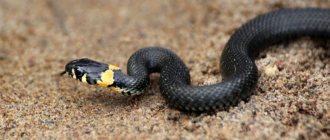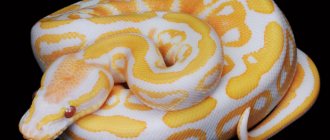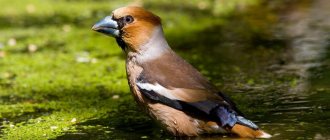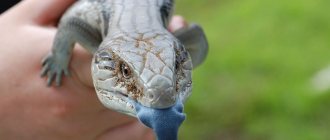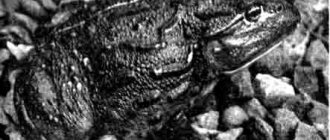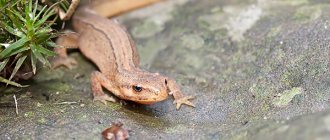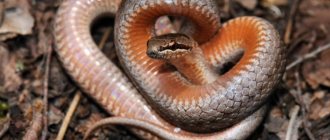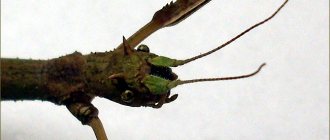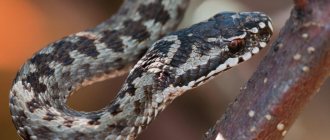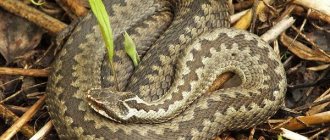Hatching ages of different snake species
Not all species of snakes take the same amount of time to hatch their eggs. In reality, the time can vary greatly, as shown in the table below.
| View | Average time to hatching | Number of eggs |
| King Cobra | 73 days | 18 – 50 |
| Corn snake | 60 days | 8 – 30 |
| Royal snakes | 60 days | 5 – 15 |
| Royal python | 55 days | 4 – 10 |
| Bull snake | 55 days | 5 – 15 |
| Asian beauty | 70 days | 10 – 20 |
| Burmese python | 64 days | 20 – 80 |
| Black Mamba | 90 days | 10 – 20 |
Oviparous (egg-laying) snakes make up 70% of all snakes. About 25% of snakes are viviparous (give a live birth), and then some species of snakes grow an egg in their mother but are then born alive (oviparous).
Physiology of male and female
Before understanding the birth process of a snake, you should know the physiology of the male and female. And here you can encounter the first problems, since it is quite difficult to visually distinguish females from males.
In the male, the fertilization organs are a pair of hemipenises located in the tail area, in the so-called pockets, on the abdominal part. One of the hemipenises grows to the required size only when a partner is nearby, ready for mating.
Did you know? There are a number of snakes that are hermaphrodites. They are characterized by parthenogenesis, a “virgin” method of reproduction in which female cells develop in an adult body without fertilization. Among the hermaphrodites, reptiles of the Blind and Warty families can be distinguished.
Females have paired hemicliters, the location of which is almost impossible to determine. The body contains the ovaries, which are connected to the cloaca by the oviducts.
Video: how to distinguish snakes by gender
Based on their external description, you can distinguish a male from a female by certain characteristics:
How to Care for Snake Eggs While Waiting for Them to Hatch
There are two really effective ways to incubate snake eggs.
The first is purchasing a commercial incubator , and the second is creating one yourself at home.
Whichever route you choose, there are a few tips that can help ensure the success of your incubator.
- Whether you make it at home or buy it, you always want to make sure your incubator is running for about 48 hours before placing your snake eggs inside. This helps the climate inside to even out before the snakes appear.
- You should make sure that you have two thermometers that constantly check the temperature, and it is best if the climate is controlled by one of these thermometers.
- It is best to have something like a water bath in the incubator to ensure there is enough humidity for the developing snakes. Most commercial incubators come with one of these, but if you're making one at home, you may want to find a way to suspend the container containing the eggs in a water bath.
Where can you find snakes?
The common snake (Natrix natrix) is widespread throughout Europe, with the exception of its northernmost part, in North Africa and Asia - east to Central Mongolia, Northern China, and south to Central Iran. In Russia, this is one of the most famous snakes; here it inhabits the European part to southern Karelia to the north, to the east - to Transbaikalia.
The habitats are already very diverse. It mainly settles near bodies of water - along the banks of rivers, lakes, ponds, and irrigation canals. It can often be found in wet meadows, forest edges and clearings. It can also find shelter in gardens, vegetable gardens, old buildings, cellars, etc. In populated areas, these snakes can do without bodies of water, since they often find conditions for breeding, feeding, and wintering in one place. Heaps of manure and rotting garbage may well become havens for grass snakes.
Buying snake eggs during the incubation period
Buying snake eggs can be a very difficult and challenging task. Some eggs are not available for purchase because they can carry diseases, and selling some types of eggs may even be illegal. Those eggs that are legally sold must be handled with great care when purchased.
Unlike bird eggs, which can wait a few days before incubating and therefore can be shipped, snake eggs are delicate and need to be incubated quickly once they are laid. Your best bet is to find a pregnant snake in your area whose eggs you can collect immediately after they are laid.
Since they are delicate when transporting them back to your home, you must be careful to never let them knock them over. Marking the vertical side can be a good tip to help you remember how the snake should be oriented.
Skids
These are large snakes, reaching sizes of two or more meters in length. There are also several dozen species of them. They are also found in our country, especially in the south of the Far East. In the kingdom of snakes, snakes are excellent sprinters. Small individuals prefer to run away, but large ones can also show aggression towards humans. Although snakes are not poisonous, their large, dog-like teeth can cause wounds. The yellow-bellied snake is especially aggressive, which is found in Ukraine, in the countries of Transcaucasia and in our Lower Volga region up to the Ural River. When cornered, he gets right in the face. The spotted snake is not far behind him in his desire to stand up for himself. Its habitat is Central Asia. And the largest non-venomous snake (unless, of course, you count pythons and boas) is the big-eyed snake. It reaches a length of three and a half meters.
Do snakes incubate eggs before hatching?
When you raise snake eggs yourself, you have to be very gentle and work hard to make sure the environment remains ideal for the baby snakes developing inside. Unfortunately, few developing snake eggs in the wild receive this treatment.
Most snake eggs, once laid, are left on their own to hopefully survive. But there are a few exceptions to this rule. There are some breeds of pythons that actually wrap their body around their eggs and constantly contract their muscles to produce heat. Or they will go out to sunbathe and then return to the nest, allowing their body heat to warm the eggs.
There are some species of vipers that also stay with their young after they are born until they experience their first molt. As for snakes that do not provide assistance to their developing eggs - before hatching, the female snake will find a place that seems to be the best place for her to develop, and she will lay her eggs there before leaving.
Description of the viper
The common viper belongs to the Viper family and is not large in size, about 72 cm with a weight of no more than 200 grams. As a rule, males have a slightly shorter body length.
Appearance
- The head is characterized as rounded-triangular in shape, the nasal end is blunt and has a hole in the middle. It is covered with small scales or scutes of irregular shape, while the temporal angles stand out noticeably, since paired poisonous glands are located here.
- The eyes are small, with pupils located strictly vertically. The viper has a very angry appearance due to the fact that overhanging scales are located above the eyes, although this is in no way connected with any manifestations of the reptile’s emotions.
- The upper jaws are short, but very mobile and are armed with a pair of tubular poisonous fangs, as well as two pairs of small replacement teeth. Such teeth are also located on the pterygoid bones within the palate.
- The head is connected to the body using a sharp cervical interception.
- The middle part of the body is both short and relatively thick, but at the same time the body further narrows sharply until the tail. The tail can be described as short and blunt, comma-shaped.
Vipers are distinguished by a wide variety of colors, although the main color is considered to be gray (in males) and brown (in females). In addition to the main colors, vipers of the following colors are found in nature:
- Black.
- Beige-yellow.
- Whitish-silver.
- Olive brown.
- Copper red.
As a rule, in most varieties the body is “decorated” with various stripes, spots or patterns.
For example:
- There may be a zigzag stripe on the back.
- On the top of the head you can see ornaments of various shapes, darker shades.
- Black stripes may run along the sides of the head from the eyes to the mouth.
- Dark spots may be present on the sides of the body.
Black and red-brown species of vipers do not have patterns on their heads or bodies. However, the lower part of their body may have a lighter color.
Interesting to know! As a rule, albino vipers are not found in nature, compared to other species of snakes in which the lack of basic body color is a common occurrence.
The different types of colors of the viper are associated with remaining invisible against the natural background, regardless of living conditions.
Legendary snake. Common viper
Behavior and lifestyle
The life activity of the viper is associated exclusively with the warm period, so its activity manifests itself with the onset of spring, when the sun's rays begin to warm the earth. After the soil warms up to a temperature of about 20 degrees, males begin to appear on the surface. Females begin to leave their shelters at temperatures of about 28 degrees.
The viper has no limbs or other appendages, so its behavior is directly related to its capabilities. Therefore, for most of the daytime, the viper is in shelter or exposed to direct sunlight. At the same time, the viper can lie in different ways, depending on the living conditions. When a reptile is in a relaxed state, its ribs move apart and its body becomes flat, thanks to which it can receive maximum heat from the sun's rays. In case of danger, the viper’s body becomes elastic, like a spring, and it can remain in the same position.
Interesting moment! The snake has an excellent reaction, so at any moment it can escape from danger and make a dash in the direction of potential prey.
In case of danger, the viper curls into a ball, from the center of which its head protrudes, on a curved neck resembling the shape of the letter “S”. If necessary, the snake begins to make frightening sounds and throw its head forward. At the same time, she moves with this ball towards danger.
At dusk or at night, the viper goes out hunting in search of food. At the same time, she easily moves and examines various shelters where various animals included in her diet can hide.
The viper has good eyesight and an excellent sense of smell. This allows her to penetrate even into rodent burrows, where she easily copes with both adults and young ones.
The viper is capable of not only actively seeking food for itself, but also being in ambush, waiting until potential prey itself appears within the viper’s direct throw. If the snake is unlucky and misses, then it will not pursue its victim, but will lie in ambush until it is lucky. If the viper is lucky, it will not appear on the surface at all for several days, but will remain in its shelter, digesting food.
A well-fed viper or one that is not hunting never shows aggression first. Therefore, when encountering danger or a person, she tries to crawl to a safe place, especially if she is provoked to attack.
At the first signs of cold weather, vipers try to settle into their winter “apartments”, so the cold snap of these reptiles will never take them by surprise. At the same time, it should be noted that almost all individuals survive until spring, which is associated with a number of explanations.
For example:
- Rodent burrows located below the ground freezing level serve as shelters for vipers.
- Vipers overwinter in a close community of several dozen individuals, warming each other.
- Vipers can easily predict the arrival of the slightest cold snap. How they do this is still unknown to scientists.
Vipers spend up to six months in winter “apartments” and only in the spring, with the onset of real warmth, do they appear on the surface of the earth.
How long do vipers live?
In the wild, vipers live no more than 15 years on average. For this type of reptile, this is no small term, given a number of factors that negatively affect life expectancy. Vipers kept in serpentariums, snake nurseries, and also in home conditions live for at least 20 years. And this is not surprising, since they feed regularly, live in conditions close to natural, they have no natural enemies, and besides, they have timely veterinary care.
Interesting to know! Experts suggest that the lifespan of vipers depends on the frequency of mating. Therefore, populations living in colder regions live longer.
Venom of the common viper
Viper venom is nothing more than a high-molecular compound of protein structures that can have a hemolytic and necrotizing effect on the composition of the blood. In addition to protein components, the poison contains neurotoxins that have a negative effect on the functioning of the cardiovascular system. Despite this, the bite of a common viper rarely leads to the death of a person, since the concentration of damaging substances is not too high to kill an adult. As for children, as well as pets, a viper bite can lead to a number of serious consequences, such as:
- State of shock.
- Blood clotting.
- Manifestation of acute anemia.
After a snake bite, even if first aid is provided and there is a visible improvement in your health, you must consult a doctor as soon as possible.
Viper venom, oddly enough, has healing capabilities, therefore it is widely used in medicine for the production of analgesic, absorbent, anti-inflammatory and painkillers. In addition, viper venom is used in the production of cosmetics. In this regard, the common viper is considered an important object of economic and scientific interest.
Common viper. How to avoid a viper bite? First aid in case of a snake bite
Habitat
The common viper has a fairly wide habitat, so it can be found on the Eurasian continent, starting from Sakhalin, northern Korea, as well as northeastern China and ending with Spain and northern Portugal. On the territory of Russia, the common viper is distributed throughout almost the entire central zone, starting from the Arctic Circle and ending with the steppe strip in the south. At the same time, populations, depending on the natural environment, are distributed unevenly:
- In conditions unfavorable for the viper’s habitat, the density of individuals is up to 0.15 pieces per 1 km of route.
- In conditions most favorable for the viper’s habitat, the density of individuals reaches 3.5 individuals per 1 km of route.
Typically, in natural conditions, vipers are found on the outskirts of moss swamps, in forest clearings, in overgrown burnt areas, in clearings of mixed and coniferous forests, on the banks of rivers and various reservoirs. The viper is also found in the mountains, at altitudes up to 3 thousand meters.
As a rule, vipers lead a sedentary lifestyle and are rarely seen more than 100 meters from their nests. With the onset of spring, some movements of adult individuals are possible over a distance of up to 5 kilometers, while vipers can swim across fairly wide rivers and other bodies of water. Vipers are also found in cities and other populated areas, where they can settle in forested areas, as well as in the basements of various buildings, in vegetable gardens and other farmland areas.
What do they eat?
The traditional diet of these reptiles consists of warm-blooded animals, although on occasion they can also feast on cold-blooded fauna such as frogs and lizards. There are cases when a snake ate its brood. Vipers are considered to be quite voracious creatures and can consume several frogs or rodents at one time. Despite such indicators, vipers can live without food for six months or more. Such characteristics are inherent at the biological level. For example:
- In winter, the common viper is in a state of suspended animation, and it uses the reserves of its body to ensure vital processes.
- Snakes may starve due to the lack of their usual food supply.
The main food of reptiles is a source of moisture for them, although sometimes vipers receive a lack of moisture due to dew or raindrops.
How do they reproduce?
Somewhere in the 4th or 5th year of life, vipers become sexually mature individuals. As a rule, these reptiles reproduce every year, with the exception of colder regions, where offspring are born once every 2 years. The mating season occurs in May and can last up to 3 weeks. During this period, vipers can be present either in pairs or in groups of several individuals twisted into a ball. Males determine the location of females by smell, and they organize peculiar fights to win the sympathy of females. Most likely, this is some kind of ritual that has its own rules.
Males stand in front of each other, raising their heads and swinging them from side to side before pouncing on each other. They collide with their bodies and seem to be intertwined with them, while each of the opponents tries to press the opponent to the ground, turning him over on his back. The most interesting thing is that they do not use their main weapons against each other, so in this confrontation they do not bite. The winner retains the right to fertilize the females. The mission of the males ends at this stage, since the fertilized female will take care of her offspring herself. At the end of the mating season, males retire and lead a separate lifestyle.
Vipers are viviparous representatives of this family, so the process of egg development occurs inside the females, after which the cubs are born ready for independent life. The number of embryos can range from 10 to 20, and not every egg produces offspring. Often, some of them freeze and then dissolve, so on average about 10 baby snakes are born. After mating, they are born after about three months, from mid-July to September. The cubs are just over 15 cm long and are complete copies of their parents.
It is important to know! Newly born viper cubs are distinguished by the fact that they are as poisonous as their parents, so it is better to avoid them.
After a maximum of a couple of days, the young offspring begin to molt, after which they scatter in different directions in search of food. During the remaining time before the cold weather, young vipers actively grow, eating various insects and worms. They winter together with adults in their shelters.
Natural enemies of the viper
There are a sufficient number of animals in the natural environment that are not afraid of the poisonous fangs of reptiles. These include:
- Badgers.
- Foxes.
- Ferrets.
- Wild boars.
In addition to animals, vipers are hunted by such birds of prey as:
- Owls.
- Herons.
- Storks.
- Snake eagles.
Forest hedgehogs often engage in fights with vipers, although these reptiles are not part of their diet. And yet, the main enemy of the viper is man, who absolutely thoughtlessly destroys them when necessary and when not necessary. They suffer from the fact that they are constantly hunted by snake catchers to get poison. Many incompetent terrarium keepers also catch snakes, since it has recently become fashionable to keep pets at home.
When is the right time to help your snake hatch?
Once your eggs are pressed together and have been developing for about 52 days, the hatching process can begin. All snakes develop differently, and some develop faster than others. In general, all of your viable eggs should begin to hatch within the same 48-hour period started by the first snake to hatch.
There may be an egg in your party that the snake cannot fit into, and this may cause you some anxiety. There really aren't any guidelines for when to help a snake hatch, but if the snake hasn't hatched yet and it's been 48 hours since the first snake hatched, help may be needed.
The baby snake may not be strong enough to break the shell on its own and may die, so if you want to help, you can make a small cut in the shell.
This can be dangerous if you cut the snake or damage the membranes (or yolk) that the snake uses to survive. Helping your snake hatch can be dangerous, but sometimes it is necessary to protect the life of a weak hatchling.
Nutrition
Vipers eat quite varied. Depending on the season and the abundance of available food, one or another type of prey may predominate in the diet. These can be mouse-like rodents, frogs, insects. In summer, they often eat the chicks of ground-nesting birds.
Having noticed the victim, the snake slowly approaches it, suddenly makes a lightning-fast throw and plunges its poisonous teeth into its body. Then he waits until the victim dies, slowly examines it, finds the head and begins to swallow prey from it, without entwining it or helping himself with body coils.
Breeding frequency
Under natural conditions, the breeding process of snakes is seasonal - spring and autumn. In most cases, the mating season of reptiles is preceded by hibernation and the process of rest.
It should be noted that snakes reach sexual maturity at the age of about two years after birth. In one year, females are capable of giving birth to about 100 babies, however, due to the fact that parents do not care for their offspring, most of the offspring die.
Partially refuting the generally accepted opinion that snakes lay eggs for reproduction, it can be noted that 30% of the creeping reptiles are viviparous and ovoviviparous. The process of giving birth to babies in reptiles is quite interesting and unusual.
When planning to lay eggs or give birth to babies, the female instinctively looks for the safest and most comfortable place, since immediately after birth the babies “enter” an independent life, without the support of their parents.
Lakedanzi
Chickens of this breed, which lay blue eggs, are often confused with ukheiliyu. Lakedanzi is slightly larger (1.6-2.5 kg). The color of the plumage is wild (black and red), and not monochromatic. Sexual maturity occurs at 4.5-5 months. Laying hens lay up to 200 eggs. The body is compact. The chest and wings are well developed. The comb is large, purple, with a red tint. A common feature with the Ukheiliyu is the black color of the skin, bones, and entrails. The birds are active, non-aggressive, and get along well with other members of the poultry yard.
Features of conception
As a rule, the sexual instinct in males awakens after the winter awakening. They crawl to the surface, looking for food, as well as a mate for mating.
A little later, the females awaken, however, while still in their burrow, they, by releasing a specific smell - pheromones, make it clear to the male that they are ready to reproduce. Surprisingly, dozens of suitors can flock to such fragrant “appeals”.
The fertilization process is quite interesting. All males, in order to get as close as possible to the female, curl up into balls around her and try, using one of the hemipenises that have increased in size, to get to their “goal”.
It is surprising that a reptile can retain sperm in its body for several years, while fertilizing eggs several times. As a result, only after one single mating can several litters be born.
Liuyang Wuji
This breed of chicken lays blue eggs. It is considered one of the oldest - known for more than 1600 years. Like the Wuheiliu, the Liuyang Wuji has black skin, feathers, meat, bones, and internal organs. The birds have an almost square body, a high tail, a long neck, and muscular thick legs. The comb and beard are fleshy, black or purple. The wings are strong. Roosters fatten up to 2.8 kg, chickens – up to 2.5 kg. The meat is juicy, tender, healthy. Egg production – up to 140 pcs. (55-60 g).
Lifestyle
Absolutely all types of snakes are predators.
The structure of their ribs and jaws allows them to swallow large prey completely. Some of them are picky and eat only a certain type of organism. Without food, snakes can survive for about two months.
They are equipped with a good sense of smell, many species have excellent vision, thermal and vibration sensitivity is developed, thanks to which they see perfectly day and night, and track prey as it moves.
These are ideal hunters. Quietly and unnoticed, they camouflage themselves, looking out for potential prey. Then they rush at her with unimaginable speed. Boas first strangle their prey, other species begin to eat it alive. Poisonous snakes bite and leave the victim, waiting for the moment when the poison paralyzes it.
Xin xin yayan
The bird's body is graceful, the tail is raised high in relation to the back. The neck is of medium length. The comb is leaf-shaped, large. The color can be tan, red or black. The last option looks the most impressive. Chickens weigh 1.2-1.5 kg, roosters - 1.8-2 kg. Egg production – up to 200 pcs. Sexual maturity occurs at 4.5-5 months. The shell color is bluish, green or olive. The character is calm.
Olive Eggers
Interbreed hybrids obtained with the participation of the Araucana, Ameraucana, and Marano breeds are known under this name. Birds have lush plumage - it can have different shades. There is a beautiful mane on the neck. There is a goatee and sideburns. The comb is small. The character of chickens is calm and fearless. Egg production – 200 pcs. Weight – 65 g. The shell is blue, olive or turquoise.
Ameraucana
This breed of chicken, which lays blue eggs, was bred in North America based on the Araucanian and American chickens. Birds have a harmonious physique. The metatarsus are not feathered, the paws are four-toed. The neck is of medium length, the head is decorated with sideburns and a beard - feathers grow in tufts. The comb is pisiform. The standards allow 8 color options. The most common chickens are white, black, wheat, and blue. The color of the metatarsus differs among different subspecies. General characteristics: white skin on the pads of the feet and toes.
The weight of Ameraucana hens and roosters is 2.5 and 3 kg, respectively. The meat is very tasty. Puberty occurs at 5-6 months. Egg productivity - 200-250 eggs per year weighing 60 g. The shell color is most often green or blue, but can also be brown-red.
